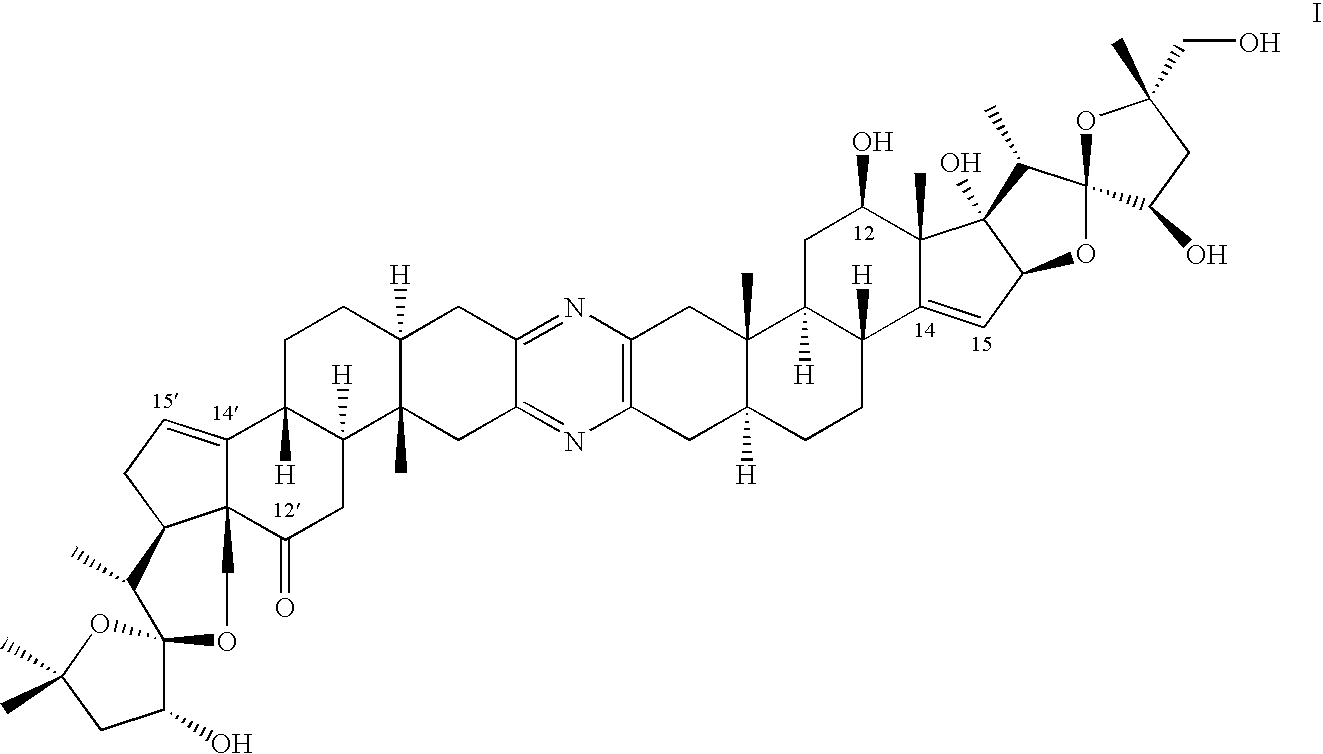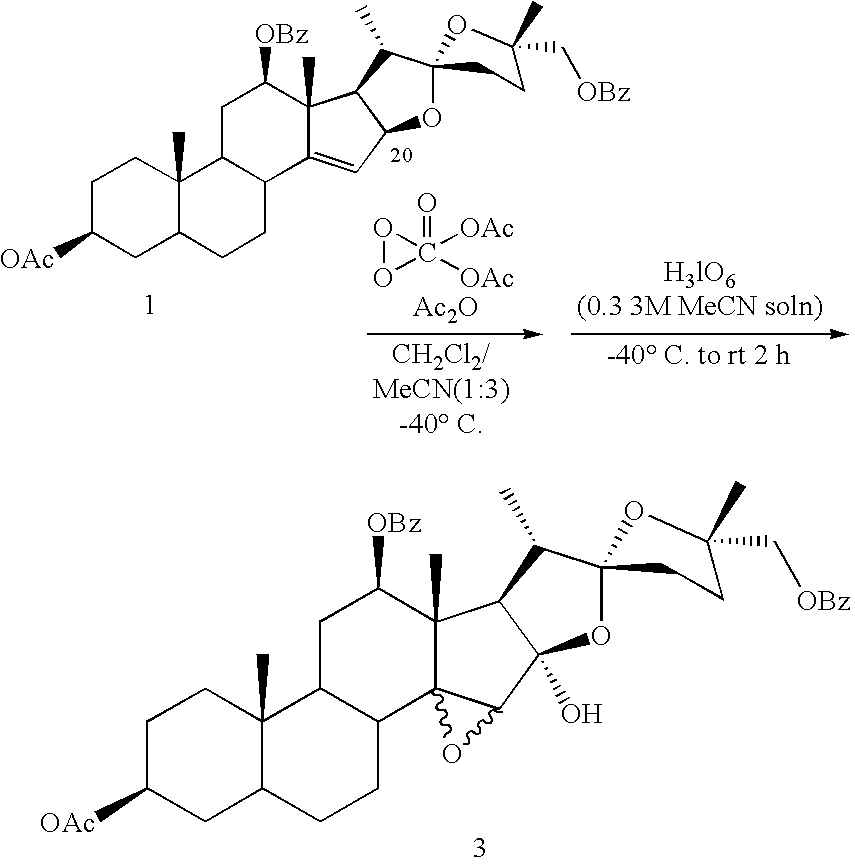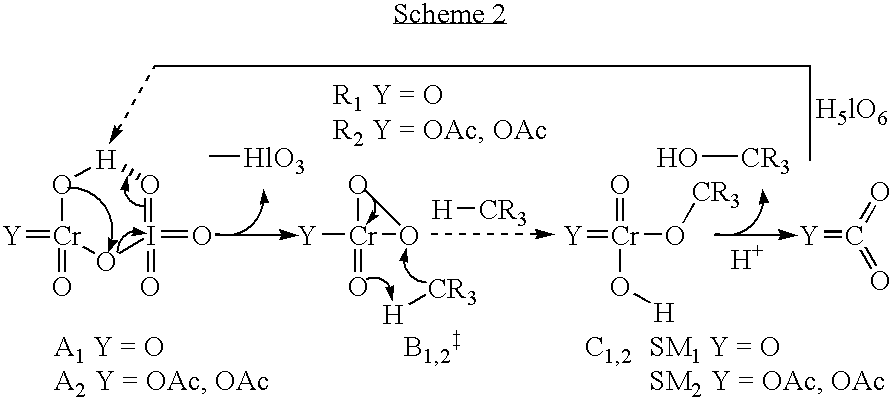Catalytic oxidation of C-H bonds
- Summary
- Abstract
- Description
- Claims
- Application Information
AI Technical Summary
Benefits of technology
Problems solved by technology
Method used
Image
Examples
example 2
Stoichiometric Method
[0106] Finely ground anhydrous chromium trioxide (300 mg, 3 mmol) was added to CH.sub.2Cl2 (1.5 mL) and CH.sub.3CN (4.5 mL) under a positive pressure of argon and the suspension was stirred vigorously for 30 minutes at ambient temperature. The chromium trioxide suspension was then cool ed to -40.degree. C. and a CH.sub.2Cl.sub.2 (1 mL) solution of a compound of formula 5 (562 mg, 1 mmol): 56
[0107] was added in one portion. After stirring 5 min at -40.degree. C., Bu.sub.4NIO.sub.4 (1.30 g, 5 mmol) in CH.sub.3CN (3 mL) was added dropwise to the mixture solution of CrO.sub.3 and the compound of formula 5 for 10 minutes. The dark orange reaction mixture was quenched by addition of saturated aqueous Na.sub.2SO.sub.3, extracted with EtOAc, washed with water, brine, dried over Na.sub.2SO.sub.4, concentrated and purified by silica gel column chromatography to yield a hemiacetal of formula 6 (433 mg, 75%, 89% based upon recovered starting material): 57
[0108] Hemiacetal 6...
example 3
[0109] To a freshly prepared CH.sub.2Cl.sub.2 solution of chromyl diacetate (O.sub.2Cr(OAc).sub.2, 1 mL, 1 M) was added dropwise a CH.sub.3CN solution of H.sub.5IO.sub.6 (0.33 M, 3 mL) at -40.degree. C. for 10 minutes to give a deep orange solution which is stable at -40.degree. C. for several hours. In a different flask, a CH.sub.2Cl.sub.2 (0.4 mL) solution of ethyl benzene (212 mg, 2 mmol) and acetic anhydride (0.38 mL, 4 mmol, 2 eq) was cooled to -40.degree. C. The earlier prepared chromium oxidant solution (0.4 mL, 0.25 M. 5 mol %) was added in one portion to the solution of starting material, followed; by the addition of a CH.sub.3CN solution of H.sub.5IO.sub.6 (0.33 M, 18.2 mL, 3 eq) at -40.degree. C. over a period of 30 minutes. The resulting orange colored reaction mixture was gradually warmed up to 0.degree. C. for a period of 1.5 h, quenched by addition of saturated aqueous Na.sub.2SO.sub.4, extracted with EtOAc, washed with water, brine, dried over Na.sub....
example 4
NMR and Mass Spectrometry Characterization of Reactants and Products
[0110] Proton NMR, carbon NMR, mass spectrometry and high resolution mass spectrometry characterizations of the aforementioned compounds of formulae 1, 3.alpha., 3.beta., 4.alpha., 4.beta., 6, 8, and 10 were determined to be as follows.
[0111] .DELTA..sup.14-Spiroketal 1: .sup.1H NMR (300 MHz, CDCl.sub.3) .delta.7.39-8.13 (5H, m), 5.30 (1H, s), 4.86 (1H, dd, J=8.1.1.5 Hz), 4.63 (2H, m), 4.34 (1H, d, J=11.1 Hz), 4.18 (1H, d, J=11.1 Hz), 2.40 (1H, m), 2.25 (1H, m), 1.99 (3H, s), 1.21 (3H, s), 1.19 (3H, s), 0.88 (3H, d, J=10.5 Hz), 0.86 (3H, s); .sup.13C NMR (75 MHz, CDCl.sub.3) .delta. 170.5, 166.4, 165.8, 156.5, 132.9, 132.8, 130.6, 130.4, 129.8, 129.5, 128.3, 128.3, 120.2, 117.6, 84.4, 82.4, 81.5, 73.2, 70.2, 56.1, 52.0, 51.6, 44.2, 41.0, 36.5, 35.9, 34.0, 33.8, 32.8, 32.3, 29.4, 28.1, 27.2, 26.6, 24.0, 21.4, 15.3, 14.1, 14.0, 11.9; MS (ESI) 719 (M+Na); HRMS (ESI) calculated for C.sub.43H.sub.52O.sub.8 (M+Na) 719.356...
PUM
| Property | Measurement | Unit |
|---|---|---|
| Length | aaaaa | aaaaa |
| Length | aaaaa | aaaaa |
| Time | aaaaa | aaaaa |
Abstract
Description
Claims
Application Information
 Login to View More
Login to View More - R&D
- Intellectual Property
- Life Sciences
- Materials
- Tech Scout
- Unparalleled Data Quality
- Higher Quality Content
- 60% Fewer Hallucinations
Browse by: Latest US Patents, China's latest patents, Technical Efficacy Thesaurus, Application Domain, Technology Topic, Popular Technical Reports.
© 2025 PatSnap. All rights reserved.Legal|Privacy policy|Modern Slavery Act Transparency Statement|Sitemap|About US| Contact US: help@patsnap.com



